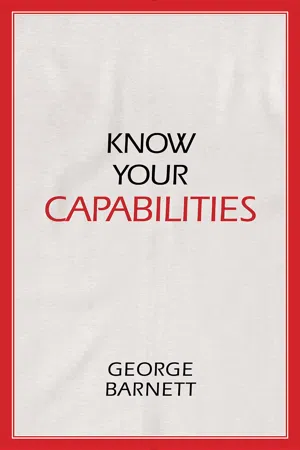![]()
The Universal Set of Capabilities
Ambiguity drives me crazy. It’s the opposite of clarity, and, if nothing else, the aim of this book is to make some things perfectly clear. Like,
Not understanding capabilities is the #1 culprit of strategic failure.
Don’t take our word for it. The research bears this out.
Every company has a corporate strategy, yet most corporate strategy efforts fail to achieve their expected results.
For example, most corporate change efforts since 1981 have fallen far short of the sustained results they set out to accomplish (by two-thirds to three-quarters, depending on whose consulting report is cited).
Take the most glaring example, the failure rate of M&A strategies. In their new book, “Masterminding the Deal”, academics Peter Clark and Roger Mills found that possibly two-thirds of all M&A efforts fail (i.e. the effort did not deliver the results promised when the deal was announced). Clark and Mills attribute this to irrational exuberance leading to the buyer overpaying for the target company. Quite often, this occurs later in the business cycle, when what we witness are cases of “strategic or transformational” mergers, terms used when a company buys its way into an unfamiliar business (i.e. does not have the capabilities for success).1
Add to this evidence the recent study by Leinwand and Mainardi, in which they point out the fact that “few strategies explicitly mention capabilities at all.”
They cite a few examples of what they refer to as coherence between a company’s capabilities and its strategy (Wal-Mart, Pfizer, Coca-Cola, P&G), noting these examples as rare exceptions to the rule.2
Round out the argument with the investigations of Sheth and Sisodia into the reasons for corporate failure and success. From their analysis, they conclude that companies succeed because, by chance or circumstance, their internal capabilities and assets seem to match the opportunities in the environment at that particular time. Alternatively, they can just as easily fail if they prove unable or unwilling to change their culture, processes, systems and structure. This phenomenon, variously described as the dominant logic, active inertia, or blind spots, is the prime cause for decline and failure, the authors argue.3
We explore this further in chapter three.
A capability means more than just a skill or a competency.
The word “capability” is used in so many different ways that it creates confusion.
Like eBay CFO Bob Swan, speaking recently about M&A strategy, “If somebody else has a competency or a capability, that if we acquire now it will be quicker than building it..., that is an important aspect of whether to buy or build.”4
You can buy a person, a team, or a product. You cannot buy a capability.
This confusion can leave you prone to making serious strategic mistakes.
A more helpful definition of a capability is the ability to get something done through the interplay of multiple elements of your business acting in concert.
For example, a defined business process for launching new products is a skill or element, whereas the ability to create and launch compelling, differentiated products over and over again is a capability.
At ClearLake, we believe that every capability is like an ecosystem — an interdependent network of tangible and intangible elements in a company’s business environment. That environment may lie wholly within the organisation’s boundaries, or it may encompass other players in its network of suppliers, partners, and customers.
Some capabilities are relatively simple, reliant on only one or two elements. Others consist of several highly interdependent elements. What all capabilities have in common is their systemic effect beyond a single functional area, often company-wide.
Our research and client work have demonstrated that you can usefully categorise the underlying elements of business capabilities into six areas: Community, Culture, Motivation, Technology, Work Streams and Knowledge (see next page).
Using the above capability as an example, we would describe “the ability to create or launch compelling, differentiated products over and over again” as a combination of Motivation (in this case, the willingness to iterate, or the passion for iteration), Technology (e.g. an ongoing exploration of the limits of, say, material science in display technology), and Workstreams (e.g. creating and nurturing the repeatability of the product development process).
People have been talking about the importance of capabilities for a long time.
Scholarly treatment of (and support for) capabilities theories of business enterprise dates back at least to the work of Alfred Chandler (e.g. his books: Strategy and Structure (1962), The Visible Hand (1977)).5
Chandler made the case that firms could excel by building organisational capabilities over the long term.
Then, in 1990, Prahalad and H...



